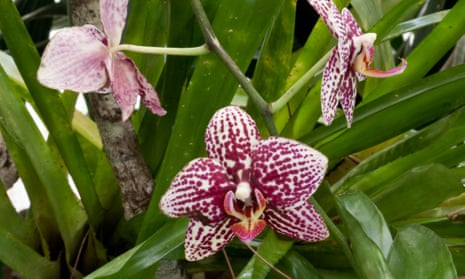My first loves, when I was young, were epiphytic orchids; their often brash otherness seemed to speak to me. I dreamed of hothouses dripping in exotic blooms and joined the Orchid Society of Great Britain. Then I went to work in one of those hothouses, and those glamorous flowers suddenly seemed a little uptight, with all their demands and high humidity needs. Slowly but surely, orchids disappeared out of my life, until a couple of years ago when my neighbour gave me a moth orchid, Phalaenopsis x hybrid, when she was moving house. I thought it was a loan and then it turned into a gift, and just when my indifference was peaking, it flowered in great profusion.

The name phalaenopsis is derived from the Ancient Greek for mothlike; it is said that when the entomologist and botanist Carl Ludwig Blume first saw them dripping off a tree on the other side of a valley in south-east Asia, he thought they were moths fluttering in the wind. Even my overbred giant pink version still hints at this – that is, if you let it off the stick with hairclips that tethers every modern orchid. The blooms are never supposed to be upright but to gracefully flop and dance in the slightest breeze.
Epiphytic orchids are the sort that grow clinging to trees and occasionally rocks (known as lithophytic) but never soil. Their alien roots, which creep like fingers out of the pot, glow white green and have specially adapted cells on the outside that allow the roots to absorb atmospheric moisture. In the wild they cling to bark to absorb rain run-off, sipping their nutrients from rotting leaf mould that catches in the cracks they inhabit.
The reason mine flowered so prolifically is, in part, thanks to its perfect position: an east-facing window bathed in good winter light, which is essential for getting the plants to reflower.
That, plus consistent watering, every week in the growing season, every other week during the winter. But I think the winning formula was feeding the plant. I use Lou’s Poo, dried alpaca poo that is a terrific fertiliser for houseplants. The tiny round “beans” are dehydrated so don’t smell; you just feed each plant a few and let them slowly rot away.

The other trick to reblooming is to not cut the whole flower spike off when the flowers finish. It takes such an effort to create those blooms that phalaenopsis often sends out a side branch of new flowers off the main stem just when it looks as if it’s dying back. If you snip it at the base, you’ll miss this.

Comments (…)
Sign in or create your Guardian account to join the discussion